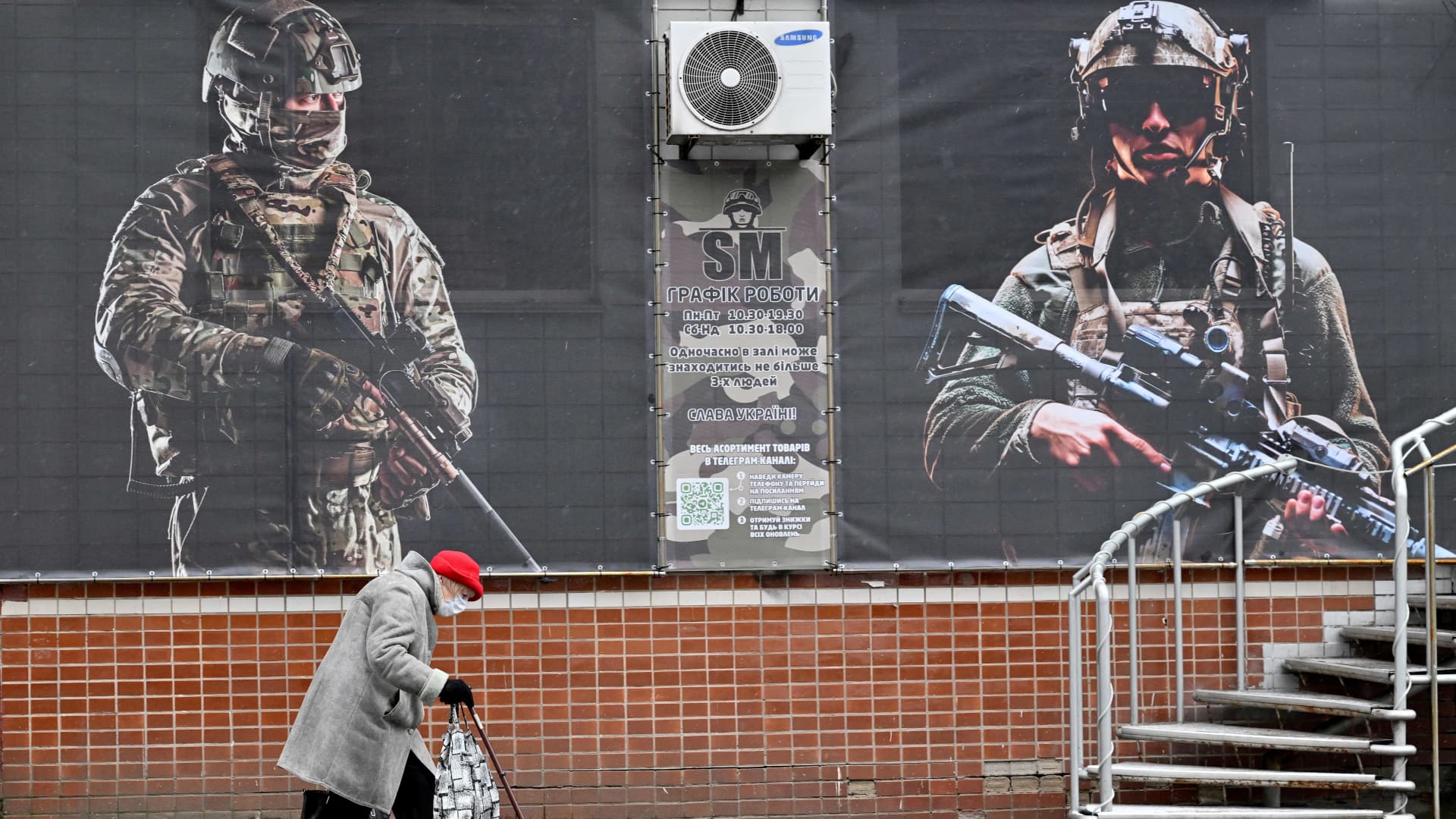“Every day, regardless of whether it is an anniversary or not, I feel pain about the captivity of my only son.”
Ukrainian mother Natalya hasn’t seen her son Dmytro, or “Dimka” as she refers to him affectionately, since the summer of 2022.
Dmytro was born into a military family and dreamed of military service from a young age. Since 2018, Dmytro had been serving in the Marine Corps in Mariupol in southern Ukraine.
When Russian forces surged into the east and south of the country during the initial invasion in February 2022, the port city was a key target for Russian forces looking to seize territory in the Donetsk region.
An intense battle for control of the city ensued with Ukrainian forces surrounded and bombarded in what became known as the “Siege of Mariupol.” The bloody siege ended in late May 2022 after several thousand Ukrainian soldiers and civilians who had been holed-up in the city’s Azovstal steelworks for months surrendered and were captured, marking a bitter defeat for Ukraine.
Dmytro was injured in Mariupol when a tank he was in was struck by heavy shelling, leaving him with injuries to the head and spine. He was captured in another of the city’s major steelworks, the Illich Steel and Iron Works, during an attempt to break out of the factory following its Russian encirclement in April 2022.
Natalya told CNBC she was grateful to know her son was alive after hearing of his capture in October 2022 from a soldier who had been in the same cell as Dmytro before being released. She has not heard of or from Dmytro since, however.
“It is hardest for me on his birthday, when memories of his past happy life reappear, how he grew up, how he was brought up,” Natalya told CNBC in emailed comments.
“It hurts me very much that I am a mother and cannot bring my son home.”
Dmytro is just one of an estimated 4,000 Ukrainians who are still being held as prisoners of war in Russian detention facilities. Around 2,000 of them are known as the “Defenders of Mariupol” in Ukraine, and are seen as heroes for their efforts and sacrifice in trying to defend the city before it fell to Russian forces.
Among those captured in Mariupol were around 700 fighters belonging to the Azov Battalion, who were a significant part of the defending forces making a final stand at the Azovstal steel works.
They, like other captured soldiers, were taken to Russian prison camps both in occupied parts of Ukraine and in Russia itself.
Similarly to the experience of other hostages, Dmytro was first detained in Olenivka prison in the Russian-occupied area of Donetsk in eastern Ukraine but he was later moved to a pre-trial detention facility in the Bryansk region of western Russia. He was then transferred to Tula region, south of Moscow. Since then, Natalya has not heard any word on the health or wellbeing of her son.
Many of the families of Ukrainian POWs have no idea where they are or if they are still alive after one-and-a-half years in captivity.
Iryna’s son Vladyslav was also captured in Mariupol before being taken to Russia. At age 21, he’s likely to be one of the youngest POWs in custody.
Vladyslav had dropped out of high school to join the army at 18, and had worked in air reconnaissance navigating drones before he was captured. He managed to sneak a phone into custody and was able to tell his mother what had happened to him, but they have since lost touch. There has been no new information or any communication for over a year now.
Vladyslav was in Olenivka prison for just four days before he was transferred to the town of Galich in Kostroma, Russia.
“I found out about his captivity from a phone call from my son and later his military base confirmed this fact. We started communicating with the Ukrainian authorities since the opening of the coordination headquarters for the treatment of prisoners of war on August 10, 2022,” she told CNBC.
Since his capture, Iryna has been liaising with Ukraine’s authorities regarding his welfare and efforts to include him in a future prisoner exchange. She said that while the Ukrainian government was doing everything possible to return the prisoners of war, “this is not enough.”
“We need more international publicity and support from all countries of the world in covering this topic. And a reminder that more than 4,000 Ukrainian soldiers are in captivity and waiting to return home,” she added.
Iryna and Natalya preferred to keep their surname anonymous due to safety concerns.
Successful prisoner exchanges have been held between Russia and Ukraine during the war but these have stalled of late with the last one taking place in August 2023.
Oleksandr Didur, a serviceman of the 36th Separate Naval Infantry Brigade, was among the last prisoner exchanges, having been released in a swap in July 2023. Didur had been captured in Mariupol in May 2022 after being severely injured when his unit was shelled at close quarters by a Russian tank.
Suffering numerous shrapnel wounds, Didur also lost his left eye in the attack as well as three fingers on his right hand, while his left hand was smashed by flying debris and his teeth were knocked out in the blast. Heavily-wounded, Didur was rescued by his fellow serviceman, who risked their lives to drag him from the shelled building to get him to safety.
Didur was initially treated by Ukrainian medics who presumed he would die from his injuries. Defying the odds, Didur survived but was soon captured by Russian forces, an experience he remembers little of given his injuries and pain. “It is difficult to talk about the first feelings [I had] as it was difficult for me to realize — because of my injuries — where I was and who was around me,” he told CNBC.
Didur was initially transferred to the Olenivka prison and then was moved to Horlivka, where he said there was physical and psychological abuse.
“Similarly to the others, there was physical and moral abuse. Of course there were guys who were treated even worse than me, but in principle they [the Russians] did not distinguish between the wounded and the more healthy ones,” he said.
During captivity, he said he thought about being freed every day, noting that “as a prisoner of war you wait for the exchange every day,” he said. In July 2023, that day finally came for Didur but thousands remain in captivity.
A commission set up by Ukraine’s Ministry of Reintegration of the Temporarily Occupied Territories of Ukraine said in November that, according to their analysis, 4,337 people are still prisoners of war (comprised of 3,574 military personnel and 763 civilians). It noted that 1,953 had been released from Russian captivity.
The number of prisoners of war could be higher, human rights groups say, and both Russia and Ukraine are tight-lipped about the exact numbers of prisoners they hold, including those that have surrendered voluntarily.
Both sides have also alleged that abuses have taken place in custody, ranging from degrading and humiliating treatment to torture and murder. The U.N.’s Human Rights Monitoring Mission in Ukraine expressed concern over the respective treatment of both Russian and Ukrainian POWs. In a report in October it said it had collected testimonies of survivors describing “unimaginable cruelty” in custody.
Unlike Ukraine, however, Russia has not allowed independent observers to have full access to Ukrainian POWs at detention and internment facilities.
Both sides have also seen the capture of prisoners as a bartering tool, with Ukraine’s President Volodymyr Zelenskyy praising any additions made to Ukraine’s “exchange fund.” He has also said previously that some prisoner exchanges take place on the battlefield, aware from public sight.
Nonetheless, regular protests have been held in Ukraine by families of prisoners of war, urging the Ukrainian government to remember their plight and to continue to work for their release. Organizations such as the “Heart of Azovstal” aim to keep the sensitive issue of prisoners of war high on the public agenda and maintain close relationships with the families of POWs, looking to support them and former prisoners of war like Oleksandr Didur.
Zelenskyy said on Tuesday that the recent slowdown in exchanges with Moscow was due to unspecified “reasons” on the Russian side, Reuters reported. Zelenskyy said he was hopeful the swaps could resume and that Kyiv was working on the exchange of “a good enough number of our boys.”
Ukraine’s human rights commissioner Dmytro Lubinets said in November that Russian POWs Ukraine had expressed a wish to be exchanged but commented on Telegram “no one from the Russian side wants to take them back.” Russia’s Ministry of Defense has not responded to CNBC’s request for comment.
Natalya said Kyiv had to keep trying to bring her son, and others, home, saying the “government should use all means to bring back our defenders, including [the] involvement of international organizations, especially third countries, in this process.”
Didur recognized that the process was difficult. “I have experienced that if Russia does not want to give up prisoners, it is difficult to force them, but I want our government to take an active part, because there are still many of our people there, there are also seriously wounded, sick, women who urgently need help,” he said.
As the war rages on through a second winter, Natalya will see another Christmas without knowing her son’s whereabouts, or fate. Reflecting on the ongoing conflict, Natalya said “war is always grief and death.”
Iryna said she felt both hope and despair at the situation: “My son’s birthday is in January – he will be 22 years old, it will be the second birthday of my son in captivity. There is a complete absence of a festive mood, but there is hope for a New Year’s miracle,” she said.
For soldier Oleksandr Didur, the road to recover continues. He is currently in hospital awaiting further treatment of his eye and several surgeries on his remaining hand to restore its function. Didur is also looking ahead to the eventual reconstruction of Ukraine.
“I hope for a speedy end to the war and the reconstruction of our country in which I also want to participate, and for my children not to be forced to flee but to live in their free Ukraine,” he said.
This story has been updated to remove the last name of a source, who cited safety concerns.






